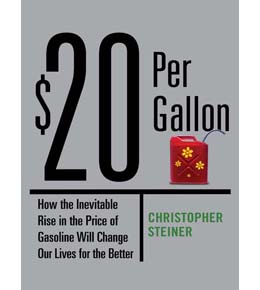The world is literally running out of gas.
And it’s going to change everything—not just your commute to work and your carpool, but also the way the countertops in your kitchen and your carpets are made. The era of cheap, petroleum-derived plastic, as well as cheap airfare, travel soccer leagues and so many other things, will be O-V-E-R.
If you can’t picture how different your life will be when gas costs $8 or $10 per gallon, don’t worry: Forbes senior staff reporter Christopher Steiner, who lives in Evanston, lays out a powerful if somewhat utopian vision for a post-gasoline world in his recent best-selling book, “$20 per Gallon: How the Rising Cost of Gasoline Will Change Our Lives for the Better” (Grand Central, 2009). Like the recession, rising gas prices will force our society to come up with creative solutions that could make our lives better, Steiner argues.

And while expensive gas will be a death sentence for many suburbs, the North Shore is in better shape than you might think. Make It Better sat down with Steiner to talk about why he lives here and what we all can do to get ready for change.
MIB: What can people do to prepare for $20-per-gallon world?
CS: How you live comes down to where you live.
At the next transition point in your life, if you’re thinking about moving, move to the dense area, move to the townhouse that has plenty of room, maybe no backyard, but you can walk to tons of stuff. Reduce your number of cars if possible.
Those are the types of choices I’d be making in the next 10-15 years. You’ll pay a little more [for real estate] now, but in the future you’ll pay even more. Put yourself in a position where a gas hike isn’t going to hurt you that much.
MIB: Are you seeing people on the North Shore prepare for change already?
CS: People here are in a position to adjust. Priuses and hybrid Lexus SUVs are everywhere.
Getting down to Wilmette and Evanston, tons of people ride their bikes. If you look at the bikes racks at the train stations, they’re packed.
MIB: What changes are you least—and most—looking forward to when gas becomes scarce?
CS: I’m least looking forward to not being able to jump on a plane like jumping in a taxi, for $200. As soon as we see gas at $6-8 a gallon—in the next 10 years—those plane tickets will never come back.
I’m most looking forward to—and this may be a couple decades in the future—getting on a train in Chicago and getting off 7 hours later in Manhattan. When plane travel becomes [really] expensive, people will get behind trains.
The Midwest network,we’ll see that in the next decade-and-a-half—with trains that go at least 150 mph. That’s a reality other countries already have.
MIB: You write that suburbs will die out, and cities will become denser and more vibrant as a result of high gas prices. What will $20 per gallon mean for the North Shore?
CS: The North Shore has a pretty good future. It’s desirable for a lot of reasons, and one is that there’s a great train line that goes right up the heart of it.
It was built this way before automobiles were king, and to some degree, it still operates that way. Other suburbs 45-minutes-to-an-hour outside the city were built for the automobile. They don’t even have sidewalks.
On Central Street in Evanston, [where I live], if you look at the home values close to the train station, it’s clear that people value being close to the grocery store, the train, etc. I can walk to more things within 3 blocks of my house where I live now than when I lived in the city.
Almost all of these suburbs have vibrant downtowns. You don’t see that in newer suburbs. A lot of people work in Wilmette and Evanston, and that’s going to keep these places attractive. There’s economic gravity.
If you live anywhere near that train corridor, you can walk to the train and you can also walk to a lot of stores. It is suburban, but not in the way we think of new suburbia. It was built before sprawl, when people still lived local lives. It’s a good place to be.

